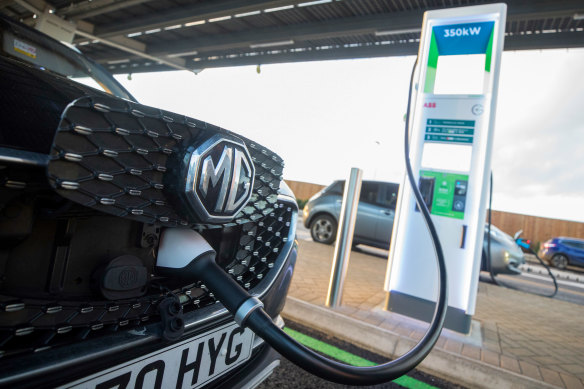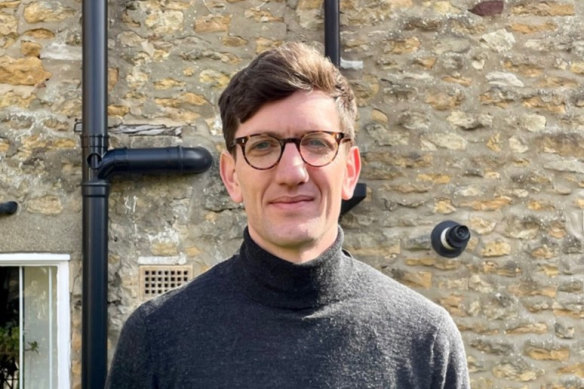This was published 8 months ago
Uber shuts out hybrids in favour of pure EVs to chase green goals
By Adam Carey
Global ride-share giant Uber will lock hybrid cars out of its emerging green option in favour of fully electric as the company steps up its goal of being 100 per cent emissions-free in Australia by 2040.
The proportion of Australian Uber rides taken in an electric car rose above 5 per cent last month, still well behind London’s world-leading rate of 30 per cent, but high enough for the company to take a punt on offering local passengers an EV-only option.

An MG ZS EV receiving a charge.Credit: Bloomberg
Christopher Hook, Uber’s Global Head of Sustainability, said the company had been waiting for the moment when it felt it had enough EVs on the road to ramp up its “Uber Green” option, which will run from early next year on their app and be reserved for fully electric vehicles.
“Five per cent sounds pretty small. It’s not a massive number, but you don’t actually have to get to a very high number for it to be pretty reliable because that’s still hundreds of vehicles, and they tend to also be concentrated in certain areas,” Hook said.
“The rationale is, do we feel like we have enough to offer a decent product? Because the red line for us is it has to be reliable.”
Uber Green has been available in Australia since June last year. Currently, anyone who chooses the option can travel in a hybrid or an EV, but Uber will remove hybrid vehicles – which have an internal combustion engine and an electric battery – from the option by March, meaning hybrid drivers will only be able to pick up passengers who choose UberX or the pricier Uber Comfort.
Uber’s zero-emissions target of 2040 in Australia puts the nation at the back end of the US-based company’s queue for full electrification. Europe, the US and Canada all have a 2030 target, although Hook conceded this will be tough to achieve on current trends.
He said unsympathetic policy conditions were a big part of why there are fewer electric cars available on its app in Australia than in many other countries.
“Australia didn’t have fuel economy standards until relatively recently. That was unusual globally, and it meant that a lot of cars that weren’t sold in other markets got sold in Australia, and it suppressed the demand for, or the need for, newer models,” Hook said.
The latest Automobile Association data on car sales in Australia reveals petrol and diesel cars accounted for three in four cars sold in the second quarter of this year. Hybrid vehicles made up 14.9 per cent, battery EVs 8.1 per cent, and plug-in hybrid EVs 1.5 per cent.

Christopher Hook, Uber’s global head of sustainability, in London.
Transport is the third-largest source of carbon pollution in Australia, accounting for 19 per cent of emissions in 2023.
The Australian government released its electric vehicle strategy early this year, but it did not include targets for new car sales. Labor took a target of 50 per cent of new cars being EVs by 2030 to its failed 2019 election campaign, in which it was accused by then prime minister Scott Morrison of planning to “end the weekend”.
Uber subsequently began offering Australian drivers a 50 per cent discount on service fees if they used an electric vehicle, saving them up to $3500 a year.
That deal, which is due to expire by mid-2025, has helped to deliver a steep jump in take-up since 2021, when Uber had fewer than 100 electric cars in service across the country.
Uber now has more than 5400 electric vehicles operating in Australia, more than double the 2400 cars it had just 12 months ago. Drivers are switching to an EV at four to five times the Australian average, the company says.
Speaking at an industry event in London on Tuesday, Uber chief executive Dara Khosrowshahi said the company would only achieve its zero-emissions goal with the help of governments around the world.
“The fact is that we can’t do this alone,” he said. “The reality is that we will only reach our zero-emission goals if policymakers and other businesses do their part as well.
“We need more affordable EVs. We need stronger EV mandates. We need incentives for people who are driving the most, and we want to make sure that chargers are available in every community, not just the wealthiest,” Khosrowshahi said.
The reporter travelled to London as a guest of Uber.